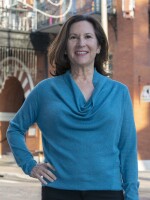When it comes to children, the definition of homeless includes more children than you may think.
Under the federal McKinney-Vento Homeless Assistance Act children and youth who "lack a fixed, regular, and adequate nighttime residence are considered homeless." That means children who are living in motels, hotels, trailer parks, or camp grounds -- or doubled-up with relatives or friends --are homeless, as well as those who stay in shelters, on the street or in abandoned buildings.
This week on Florida Matters (Tuesday, July 28 at 6:30 p.m. and Sunday, Aug. 2 at 7:30 a.m.), we’re taking an in-depth look at homelessness among Florida’s students with Jamie Myer of Metropolitan Ministries in Tampa; Ellen McLaughlin of the Schoolhouse Link program at the Sarasota Y; and Zachary White with the Homeless Empowerment Program in Clearwater.
Summer means an increase in need, according to Micki Thompson, the executive director at 211 Tampa Bay Cares. The hotline in Clearwater is a referral service for families and individuals facing the possibility of homelessness.

"The peak time at 211 across the board is the summer, due to many trends," Thompson said. "When kids are out of school those who were on free and reduced lunch in the school are now home. So you can imagine your electric bill goes up because people are home. Water bill goes up. So a lot goes up during the summer, and it's warm here in Florida during the summer. So there are more calls to 211 in the summer for needed help."
There are about a dozen kids are playing in a large room at the Homeless Empowerment Program or HEP, in Pinellas County. Most are busy gluing plastic bottle caps into different shapes to make art.
There are boys and girls, all between the ages of about 6 to 12.
Noah Holmes is 12. His family is now staying at HEP.
He remembers the hotel, the last place where he stayed with his mom and little sister. He can describe it in just one word.
"Bad," Noah said. "You can't go at least ten feet without smelling weed or pot or something. Just the place was bad."
Michelle Holmes is mother to Noah and 7-year-old Emma. The family was evicted from their apartment not long after she lost her job. Her pastor recommended she call HEP.
"Without this I don't know where we would be," Holmes said. "I don't know. Like, I don't want to say we would have been living on the streets but that may have been our next step."
Holmes says she has noticed a difference in Noah since their housing worries started.
"With Noah, his demeanor has changed a little bit," Holmes said. "He's very pouty and quieter. I definitely think it effects them at school. I don't think they know how to express what to tell everyone."
The American Psychological Association says as schooling for homeless children is interrupted or delayed, they are twice as likely to have a learning disability, have to repeat a grade or be suspended from school.
Holmes says the Pinellas County School system knows that the family is homeless, and is staying at HEP.
"And they were very supportive of the situation," Holmes said. "If we were late, getting her on the bus. Because she missed a couple of days because they were getting her a bus from the hotel. So she missed a couple of days and they really worked with her well."
So how many students like Noah and Emma are there? The exact number is hard to determine. According to 211 Tampa Bay Cares there were around 2,200 homeless students in Pinellas County.
The term homeless students has a broader definition than you may think. It includes students who are living in trailer parks, hotels or with extended family.
It can be difficult to get an accurate count of homeless students, especially as they get older when they couch surf or move around a lot.
Ken Gaughan supervises social work for Hillsborough County Public Schools. He says they have been trying to figure out how many homeless students they may have.
"We've been talking to other communities and experts in the field about what should our number be, what does it look like?" Gaughan said. "And the input we get is, you need to look at your free lunch count in the district and our free lunch count is pretty high. It's around fifty-five percent. They say about 10 percent of your free lunch population is also homeless. And that's a pretty big number."
Doing the math, that means about 11,000 students in Hillsborough County may be at or near homeless.
Meanwhile, Noah Holmes says he is just glad his family is together at the Homeless Empowerment Program. And he hopes it means a fresh start for all of them.
"I hope it helps my family get back on our feet," Noah said. "Instead of just keep falling and falling. So we just move up from where we used to be."
His mom is going through a six-week computer training class at HEP. She hopes it will improve her chances at finding a good job and a permanent home of their own.






